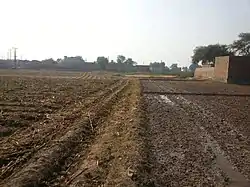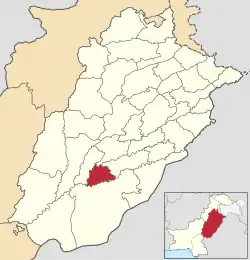Lodhran District
Lodhran District (Saraiki: ضِلع لودهراں), is a district in the province of Punjab, Pakistan, with the city of Lodhran as its capital. Located on the northern side of the River Sutlej, it is bounded to the north by the districts of Multan, Khanewal and Vehari, to the south by Bahawalpur, to the east lie the districts of Vehari and Bahawalpur; while district Multan lies on the western side.
Lodhran District
ضِلع لودھراں | |
|---|---|
 Field in Lodhran district | |
 Map of Punjab with Lodhran District highlighted | |
| Country | |
| Province | |
| Division | Multan |
| Headquarters | Lodhran city |
| Government | |
| • Type | District Administration |
| • Deputy Commissioner | Abdul Rauf Mahar |
| • District Police Officer | Hassam Bin Iqbal |
| • Chief executive officer health | Faisal Waheed |
| Area | |
| • Total | 1,790 km2 (690 sq mi) |
| Population (2017)[1] | |
| • Total | 1,700,620 |
| • Density | 950/km2 (2,500/sq mi) |
| Time zone | UTC+5 (PST) |
| Number of Tehsils | 3 |
| Website | lodhran |
Lodhran was split off as a separate district from Multan in 1991.[2] It has the lowest Human Development Index of all districts in Punjab, and is among the thirty poorest districts in Pakistan.[3]: 85 It is a well-known cotton-growing area.[2]
Administrative divisions
Lodhran District is spread over an area of 1,790 square kilometres and is subdivided into three tehsils (Lodhran, Kahror Pakka and Dunyapur) which contain a total of 73 Union Councils:[4]
| Tehsil | No. of Unions |
|---|---|
| Dunyapur[4] | 22 |
| Kahror Pakka[4] | 23 |
| Lodhran[4] | 28 |
| Total | 73 |
Demographics
At the time of the 2017 census the District Lodhran had a population of 1,700,620. Rural population is 1,434,092 while the urban population is 265,601. The literacy rate was 49.88%. Muslims are almost the entire population with 99.76%.[1][5]
At the time of the 2017 census, 74.23% of the population spoke Saraiki, 15.65% Punjabi and 9.03% Urdu as their first language.[6]
The most widely spoken first language is Saraiki (70%), which is used by the major indigenous social groups of the Joya , Baloch, Awan, Arain, Kanju, Uttera/Uttero, Ghallu, Bhutta, Lodhra, Metla, Chaner Syed, Qureshi, Tareen and Pathan. Additionally, Punjabi is spoken by about 19%. The percentage of the district's population who declared Urdu as their language at the 1998 census was 9%; this includes these Haryanvi speakers as well as other, smaller, groups of Muhajirs such as the Mughal. Additionally, the nomadic Od people are speakers of the Od language, while Pashto (0.2%) is spoken by Pashtuns.[6][3]: 83
References
- "DISTRICT AND TEHSIL LEVEL POPULATION SUMMARY (Census - 2017)" (PDF). Pakistan Bureau of Statistics, Government of Pakistan website. Archived from the original (PDF) on 27 August 2018. Retrieved 5 April 2023.
- Khan, Ahmad Fraz (18 January 2021). "Multan's mangoes and multinationals". Dawn (newspaper). Retrieved 5 April 2023.
- Mughal, Muhammad Aurang Zeb (2014). Time, Space and Social Change in Rural Pakistan: An Ethnographic Study of Jhokwala Village, Lodhran District (Thesis). Durham University website. Retrieved 5 April 2023.
- "Tehsils & Unions in the District of Lodhran". National Reconstruction Bureau, Government of Pakistan website. Archived from the original on 7 August 2011. Retrieved 5 April 2023.
- "Punjab Districts - population per 2017 census (scroll down to Lodhran District)". Citypopulation.de website. Archived from the original on 29 April 2020. Retrieved 5 April 2023.
- Lodhran District - Population Details Citypopulation.de website, Retrieved 6 April 2023
